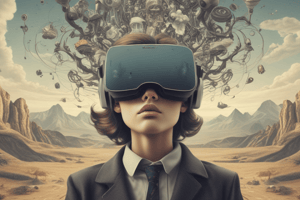Podcast
Questions and Answers
What is the main difference between sensation and perception?
What is the main difference between sensation and perception?
- Sensation and perception are interchangeable terms for the same process.
- Sensation involves encoding energy from the environment, while perception involves interpreting sensory information. (correct)
- Sensation and perception both involve interpreting sensory information, but in different ways.
- Sensation is the process of interpreting sensory information, while perception involves receiving energy from the environment.
Where in the eye does light directly focused on land?
Where in the eye does light directly focused on land?
- Fovea (correct)
- Cones
- Rods
- Ganglion cells
What is the function of saccades in visual perception?
What is the function of saccades in visual perception?
- Rapid eye movements (correct)
- Pauses between saccades
- Gathering visual information
- Analysis of visual stimulus
What is the primary role of the rods in vision?
What is the primary role of the rods in vision?
What is the brief memory of visual information when the stimulus is no longer present known as?
What is the brief memory of visual information when the stimulus is no longer present known as?
Who used a plaster of Paris cup on the cornea with cocaine to record eye movements?
Who used a plaster of Paris cup on the cornea with cocaine to record eye movements?
What is used in modern eye-tracking methods by locking onto infrared 'sinks'?
What is used in modern eye-tracking methods by locking onto infrared 'sinks'?
Who presented a grid of letters in a tachistoscopic study, showing better recall with cued conditions?
Who presented a grid of letters in a tachistoscopic study, showing better recall with cued conditions?
'Pandemonium' is a model for pattern recognition that uses which type of processing?
'Pandemonium' is a model for pattern recognition that uses which type of processing?
What refers to a later visual stimulus affecting perception of an earlier one?
What refers to a later visual stimulus affecting perception of an earlier one?
What preserves auditory stimuli for a short time?
What preserves auditory stimuli for a short time?
What does redirected attention persistence refer to?
What does redirected attention persistence refer to?
Which study showed a span of apprehension and partial report accuracy?
Which study showed a span of apprehension and partial report accuracy?
What allows the brain to use higher level knowledge to interpret ambiguous stimuli?
What allows the brain to use higher level knowledge to interpret ambiguous stimuli?
What is the technique used to study auditory sensory memory?
What is the technique used to study auditory sensory memory?
Flashcards are hidden until you start studying
Study Notes
- The eye takes in visual information during fixations.
- Measuring eye movements: Huey (1908) used a plaster of Paris cup on the cornea with cocaine to record eye movements.
- Infrared cameras are used in modern eye-tracking methods by locking onto infrared "sinks," particularly the pupil.
- Visual sensory memory, also known as Iconic Memory, is the brief memory of visual information when the stimulus is no longer present.
- Sperling's tachistoscopic study presented a grid of letters, and subjects had better recall with cued conditions (1960s).
- Iconic memory has a very brief duration and is not intuitively understood.
- A classical study on iconic memory showed a span of apprehension and partial report accuracy (Sperling's Experiment).
- Backward masking refers to a later visual stimulus affecting perception of an earlier one (Averbach and Coriell, 1961).
- The icon is not relevant to real-world perception but can be useful under certain conditions (Haber, 1983).
- Pandemonium, a model for pattern recognition, uses bottom-up and top-down processing, and its weakness is context effects (Selfridge, 1959).
- Auditory sensory memory, also known as Echoic memory, preserves auditory stimuli for a short time.
- The three-eared man procedure is a technique used to study auditory sensory memory (Darwin, Turvey, and Crowder, 1972).
- Redirected attention persistence refers to the influence of attention on memory duration, as shown in a study by Crowder and Morton (1969).
- Conceptually driven processing allows the brain to use higher level knowledge to interpret ambiguous stimuli (Warren and Warren, 1970).
Studying That Suits You
Use AI to generate personalized quizzes and flashcards to suit your learning preferences.




